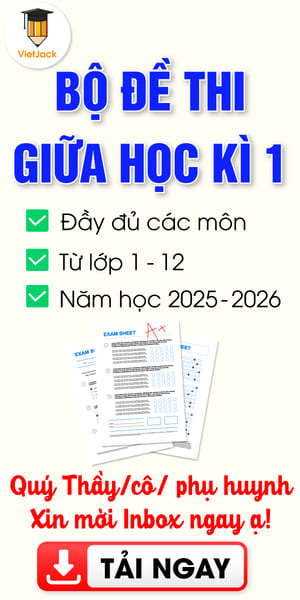Giáo án Tiếng Anh lớp 5 Global Success Unit 3 Lesson 2
Giáo án Tiếng Anh lớp 5 Global Success Unit 3 Lesson 2
Chỉ từ 200k mua trọn bộ Kế hoạch bài dạy (KHBD) hay Giáo án Tiếng Anh lớp 5 Global Success bản word chuẩn kiến thức, trình bày đẹp mắt, dễ dàng chỉnh sửa:
- B1: gửi phí vào tk:
1133836868- CT TNHH DAU TU VA DV GD VIETJACK - Ngân hàng MB (QR) - B2: Nhắn tin tới Zalo VietJack Official - nhấn vào đây để thông báo và nhận giáo án
I. OBJECTIVES
By the end of this lesson, pupils will be able to:
1. Knowledge and skills
- understand and correctly repeat the sentences in two communicative contexts in which characters ask and answer questions about someone’s personality.
- correctly say the words and use What’s he / she like? - He’s / She’s ____. to ask and answer questions about someone’s personality.
- enhance the correct use of What’s he / she like? - _____. to ask and answer questions about someone’s personality in freer contexts.
- use the words friendly, helpful, clever, active in relation to the topic “My foreign friends”.
2. Competences
- Critical thinking and creativity: learn how to ask and answer questions about someone’s personality correctly and fluently.
- Communication and collaboration: work in pairs and groups to complete the learning tasks.
- Self-control & independent learning: perform listening tasks.
3. Attributes
- Raise their awareness of good personality.
II. MATERIALS
- Pupil’s book: Page 24
- Audio tracks 29, 30
- Teacher’s guide: Pages 51 - 54
- Website hoclieu.vn
- Flash cards/ pictures and posters (Unit 3)
- Computer, projector, …
III. PROCEDURES
1. WARM-UP & REVIEW (5 minutes)
a. Objectives
- To revise the words and sentence structure What does he/ she look like? - He’s/ She’s _____. to ask and answer questions about someone’s appearance.
b. Content
- Game: Whack watermelons
c. Expected outcomes
- Pupils can correctly say the words and sentence structure What does he/ she look like?
- He’s/ She’s _____. to ask and answer questions about someone’s appearance.
d. Organisation
TEACHER’S ACTIVITIES |
PUPILS’ ACTIVITIES |
CONTENT |
Game: Watermelon whacking | ||
|
- Ask pupils to give the sentence structures about someone’s appearance. Write the sentence structure on the board. - Tell pupils that they are going to choose watermelons, then look at the pictures and ask and answer the questions about someone’s appearance. - Divide the class into two groups. - Have two pupils from each group take turns to play the game. - If they ask and answer the questions correctly, they can whack a watermelon to get points for their groups. - The group with more points wins the game. Praise the winner. |
- Give the sentence structures about someone’s appearance. - Listen to the teacher’s explanation. - Work in two groups. - Take turns to play the game. - Praise the winner. |
- Sentence structures: What does he/ she look like? - He’s/ She’s _____. - Pictures (tall, short, slim, big, long hair, big eyes, a round face, short hair) - Watermelons with points (5, 5, 10, 10, 15, 15, 20, 20 points) |
e. Assessment
- Performance products: Pupils’ performance and pronunciation
- Assessment tools: Observation; Questions & Answers
2. ACTIVITY 1: EXPLORATION (5 minutes)
a. Objectives
- To understand and correctly repeat the sentences in two communicative contexts in which characters ask and answer questions about someone’s personality.
b. Content
- Activity 1. Look, listen and repeat.
c. Expected outcomes
- Pupils can understand and correctly repeat the sentences in two communicative contexts in which characters ask and answer questions about someone’s personality.
d. Organisation
TEACHER’S ACTIVITIES |
PUPILS’ ACTIVITIES |
CONTENT |
Activity 1. Look, listen and repeat. (Track 29) | ||
|
Step 1: Ask pupils to look at Pictures a and b, identify the characters and predict what Lily’s nationality is. Step 2: Play the recording for them to listen and check the prediction. Step 3: Play the recording again, encourage pupils to point at the characters while listening. Step 4: Play the recording again, sentence by sentence, for pupils to listen, point to the sentences and repeat. Correct their pronunciation where necessary. Step 5: Draw pupils’ attention to the question What’s she like? and the answer She’s friendly. Explain that they are used to talk about someone’s personality. |
- Pupils look at Pictures a and b, identify the characters and predict what Lily’s nationality is. - Pupils listen to the recording and check the prediction. - Pupils listen to the recording again, point at the characters while listening. - Pupils listen to the recording again, sentence by sentence, point to the sentences and repeat. - Pupils listen to the teacher’s explanation. |
- Contexts: a. Linh and Nam talking about a new friend in their class. b. Nam asking about the new friend’s personality. - Speech bubbles: a. Linh: There’s a new pupil in our class. Her name’s Lily. Nam: What nationality is she? Linh: She’s British. b. Nam: What’s she like? Linh: She’s friendly. |
e. Assessment
- Performance products: Pupils’ performance and pronunciation
- Assessment tools: Observation; Questions & Answers
3. ACTIVITY 2: KNOWLEDGE CONSTRUCTION (10 minutes)
a. Objectives
- To correctly say the words and use What’s he / she like? - He’s / She’s ____. to ask and answer questions about someone’s personality.
b. Content
Activity 2. Listen, point and say.
c. Expected outcomes
- Pupils can correctly say the words and use What’s he / she like? - He’s / She’s ____. to ask and answer questions about someone’s personality.
d. Organisation
TEACHER’S ACTIVITIES |
PUPILS’ ACTIVITIES |
CONTENT |
Activity 2. Listen, point and say. (Track 30) | ||
|
Step 1: Ask pupils to look at Pictures a, b, c, and d and describe what they can see in each picture. Step 2: Play the first part of the recording for pupils to listen to and repeat the words, in chorus and individually, until they feel confident. Use the flash cards for friendly, helpful, clever and active to practise the words. Step 3: Draw pupils’ attention to the speech bubbles and elicit the missing word in the question and answer by pointing at Picture a. Play the second part of the recording for pupils to listen to and repeat the sentences in both bubbles a few times. Repeat the same procedure with Pictures b, c, and d. Step 4: Let pupils point at the pictures and say the sentences in pairs. Go around the classroom to offer help where necessary. Step 5: Invite a few pairs to act out the exchanges in front of the class. Use this link https://wheelofnames.com/ to choose pupils randomly. Extension: Have pupils brainstorm some adjectives to describe people and divide them into two groups: adjectives describing someone’s appearance (for example, tall, slim, and young) and adjectives describing personality (for example, friendly, helpful, and clever.) |
- Pupils look at Pictures a, b, c, and d and describe what they can see in each picture. - Pupils listen to the recording and repeat the phrases in chorus and individually. - Pupils listen to the recording and repeat the sentences in both bubbles a few times. Pupils follow the teacher’s instructions.
- Pairs of pupils act out the exchanges in front of the class. - Pupils brainstorm some adjectives to describe someone’s appearance that they have learnt to contrast with the adjectives to describe someone’s personality. |
- Picture cues: a. a friendly girl talking to her friends and the word friendly b. a helpful girl doing the dishes and the word helpful c. a clever boy reading and thinking of a new idea and the word clever d. an active boy exercising and the word active - Speech bubbles: What’s he / she like? Audio script: a. friendly b. helpful c. clever d. active a. A: What’s she like? B: She’s friendly. b. A: What’s she like? B: She’s helpful. c. A: What’s he like? B: He’s clever. d. A: What’s he like? B: He’s active. |
e. Assessment
- Performance products: Pupils’ talks and interaction
- Assessment tools: Observation; Questions & Answers
4. ACTIVITY 3: PRACTICE (8 minutes)
a. Objectives
- To enhance the correct use of What’s he / she like? - _____. to ask and answer questions about someone’s personality in a freer context.
b. Content
- Activity 3. Let’s talk.
c. Expected outcomes
- Pupils can enhance the correct use of What’s he / she like? - _____. to ask and answer questions about someone’s personality in a freer context.
d. Organisation
TEACHER’S ACTIVITIES |
PUPILS’ ACTIVITIES |
CONTENT |
Activity 3. Let’s talk. | ||
|
Step 1: Ask pupils to look at the picture and elicit the personality of each character in the picture. Remind pupils that What’s he / she like? and - ___. are used to ask and answer questions about someone’s personality. Step 2: Give pupils time to work in pairs and take turns pointing and asking and answering questions about the personality of each character in the picture. Remind them to look at the activities the characters do. Step 3: Invite a few pairs to come to the front of the classroom and act out the exchanges. Use this link https://wheelofnames.com/ to choose pupils randomly. |
- Pupils look at the picture and elicit the personality of each character in the picture. - Pupils work in pairs and take turns pointing and asking and answering questions about the personality of each character in the picture. - Pairs of pupils come to the front of the classroom and act out the exchanges. |
- Picture cues: Pupils in a class doing different activities that can tell their personality. - Speech bubbles: What’s he / she like? Suggested answer: What’s he like? or Look at him. He’s opening the door for the teacher. He’s helpful. |
e. Assessment
- Performance products: Pupil’s interaction and performance
- Assessment tools: Observation; Questions & Answers
5. FUN CORNER AND WRAP-UP (7 minutes)
* Option 1: Game: Whisper (ppt)
- Divide the class into two groups. Have each group stand in a line.
- Model the activity. Give the first pupil in each line a flash card. Explain that he/she must read the word (without saying it out loud!) and then whisper it to the next pupil in the line. The second pupil must then whisper it to the third, and so on. When the word reaches the last pupil in the line, he/she should call it out. The first group to call out a correct word wins.
................................
................................
................................
Trên đây là nguồn học liệu Giáo án Tiếng Anh lớp 5 Global Success miễn phí của NXB Giáo dục Việt Nam. Để xem chi tiết, mời bạn tham khảo: Giáo án Tiếng Anh lớp 5 Global Success (NXB Giáo dục)
Để mua Kế hoạch bài dạy (KHBD) hay Giáo án Tiếng Anh lớp 5 năm 2025 mới nhất, mời Thầy/Cô vui lòng xem thử:
Xem thêm các bài soạn Giáo án Tiếng Anh lớp 5 Global Success (bộ sách Kết nối tri thức) chuẩn khác:
Tủ sách VIETJACK shopee lớp 1-5 (2025):
Đã có app VietJack trên điện thoại, giải bài tập SGK, SBT Soạn văn, Văn mẫu, Thi online, Bài giảng....miễn phí. Tải ngay ứng dụng trên Android và iOS.
Theo dõi chúng tôi miễn phí trên mạng xã hội facebook và youtube:Loạt bài Giáo án Tiếng Anh lớp 5 mới nhất của chúng tôi được biên soạn theo mẫu Kế hoạch bài dạy (KHBD) Tiếng Anh lớp 5 của Bộ GD&ĐT.
Nếu thấy hay, hãy động viên và chia sẻ nhé! Các bình luận không phù hợp với nội quy bình luận trang web sẽ bị cấm bình luận vĩnh viễn.
- Giáo án lớp 5 (các môn học)
- Giáo án điện tử lớp 5 (các môn học)
- Giáo án Toán lớp 5
- Giáo án Tiếng Việt lớp 5
- Giáo án Khoa học lớp 5
- Giáo án Đạo đức lớp 5
- Giáo án Lịch Sử và Địa Lí lớp 5
- Giáo án Tin học lớp 5
- Giáo án Công nghệ lớp 5
- Đề thi lớp 5 (các môn học)
- Đề thi Tiếng Việt lớp 5 (có đáp án)
- Bài tập cuối tuần Tiếng Việt lớp 5(có đáp án)
- Đề thi Toán lớp 5 (có đáp án)
- Bài tập cuối tuần Toán lớp 5 (có đáp án)
- Ôn hè Toán lớp 5 lên lớp 6
- Đề thi Tiếng Anh lớp 5 (có đáp án)
- Đề thi Khoa học lớp 5 (có đáp án)
- Đề thi Lịch Sử & Địa Lí lớp 5 (có đáp án)
- Đề thi Đạo Đức lớp 5 (có đáp án)
- Đề thi Tin học lớp 5 (có đáp án)
- Đề thi Công nghệ lớp 5 (có đáp án)




 Giải bài tập SGK & SBT
Giải bài tập SGK & SBT
 Tài liệu giáo viên
Tài liệu giáo viên
 Sách
Sách
 Khóa học
Khóa học
 Thi online
Thi online
 Hỏi đáp
Hỏi đáp

